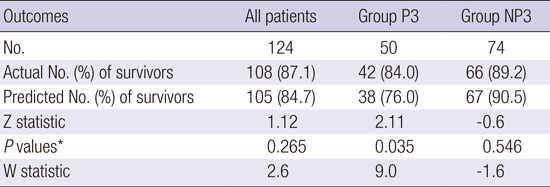2. Trunkey DD, Lim RC. Analysis of 425 consecutive trauma fatalities: an autopsy study. J Am Coll Emerg Physician. 1974; 3:368–371.
3. West JG, Trunkey DD, Lim RC. Systems of trauma care. A study of two counties. Arch Surg. 1979; 114:455–460.
4. Cales RH. Trauma mortality in Orange County: the effect of implementation of a regional trauma system. Ann Emerg Med. 1984; 13:1–10.
5. Cales RH, Trunkey DD. Preventable trauma deaths. A review of trauma care systems development. JAMA. 1985; 254:1059–1063.
6. Giannakopoulos GF, Kolodzinskyi MN, Christiaans HM, Boer C, de Lange-de Klerk ES, Zuidema WP, Bloemers FW, Bakker FC. Helicopter emergency medical services save lives: outcome in a cohort of 1073 polytraumatized patients. Eur J Emerg Med. 2013; 20:79–85.
7. Thomas SH, Harrison TH, Buras WR, Ahmed W, Cheema F, Wedel SK. Helicopter transport and blunt trauma mortality: a multicenter trial. J Trauma. 2002; 52:136–145.
8. Taylor C, Jan S, Curtis K, Tzannes A, Li Q, Palmer C, Dickson C, Myburgh J. The cost-effectiveness of physician staffed helicopter emergency medical service (HEMS) transport to a major trauma centre in NSW, Australia. Injury. 2012; 43:1843–1849.
9. Taylor CB, Stevenson M, Jan S, Middleton PM, Fitzharris M, Myburgh JA. A systematic review of the costs and benefits of helicopter emergency medical services. Injury. 2010; 41:10–20.
10. Yoon YH, Moon SW, Lee SW, Choi SH, Cho HJ, Kim JY. Helicopter emergency medical services: a report on the current status in a metropolitan area of South Korea. Eur J Emerg Med. 2011; 18:176–178.
11. American College of Surgeons Committee on Trauma. Advanced Trauma Life Support®: Student Course Manual. 9th ed. Chicago, IL: American College of Surgeons;2012.
12. Champion HR, Copes WS, Sacco WJ, Lawnick MM, Keast SL, Bain LW Jr, Flanagan ME, Frey CF. The Major Trauma Outcome Study: establishing national norms for trauma care. J Trauma. 1990; 30:1356–1365.
13. Champion HR, Sacco WJ, Copes WS. Injury severity scoring again. J Trauma. 1995; 38:94–95.
14. Baxt WG, Moody P. The impact of a physician as part of the aeromedical prehospital team in patients with blunt trauma. JAMA. 1987; 257:3246–3250.
15. Hamman BL, Cué JI, Miller FB, O'Brien DA, House T, Polk HC Jr, Richardson JD. Helicopter transport of trauma victims: does a physician make a difference? J Trauma. 1991; 31:490–494.
16. Burney RE, Passini L, Hubert D, Maio R. Comparison of aeromedical crew performance by patient severity and outcome. Ann Emerg Med. 1992; 21:375–378.
17. Schmidt U, Frame SB, Nerlich ML, Rowe DW, Enderson BL, Maull KI, Tscherne H. On-scene helicopter transport of patients with multiple injuries--comparison of a German and an American system. J Trauma. 1992; 33:548–553.
18. Baxt WG, Moody P. The impact of a rotorcraft aeromedical emergency care service on trauma mortality. JAMA. 1983; 249:3047–3051.
19. Bartolacci RA, Munford BJ, Lee A, McDougall PA. Air medical scene response to blunt trauma: effect on early survival. Med J Aust. 1998; 169:612–616.
20. Boyd CR, Tolson MA, Copes WS. Evaluating trauma care: the TRISS method. Trauma score and the injury severity score. J Trauma. 1987; 27:370–378.
21. Champion HR, Sacco WJ, Copes WS, Gann DS, Gennarelli TA, Flanagan ME. A revision of the trauma score. J Trauma. 1989; 29:623–629.
22. Champion HR, Copes WS, Sacco WJ, Lawnick MM, Keast SL, Bain LW Jr, Flanagan ME, Frey CF. The major trauma outcome study: establishing national norms for trauma care. J Trauma. 1990; 30:1356–1365.
23. Younge PA, Coats TJ, Gurney D, Kirk CJ. Interpretation of the Ws statistic: application to an integrated trauma system. J Trauma. 1997; 43:511–515.
24. Kim H, Jung KY, Kim SP, Kim SH, Noh H, Jang HY, Yoon HD, Heo YJ, Ryu HH, Jeong TO, et al. Changes in preventable death rates and traumatic care systems in Korea. J Korean Soc Emerg Med. 2012; 23:189–197.
27. Osterwalder JJ. Mortality of blunt polytrauma: a comparison between emergency physicians and emergency medical technicians—prospective cohort study at a level I hospital in eastern Switzerland. J Trauma. 2003; 55:355–361.
28. Garner A, Rashford S, Lee A, Bartolacci R. Addition of physicians to paramedic helicopter services decreases blunt trauma mortality. Aust N Z J Surg. 1999; 69:697–701.
29. Salomone JP, Salomone JA 3rd. Prehospital care. In : Mattox KL, Moore EE, Feliciano DV, editors. Trauma. 7th ed. New York, NY: McGraw-Hill;2013. p. 100–122.
30. Dick WF; Franco-German Emergency Medical Services System. Anglo-American vs. Franco-German emergency medical services system. Prehosp Disaster Med. 2003; 18:29–35.
31. Meizoso JP, Valle EJ, Allen CJ, Ray JJ, Jouria JM, Teisch LF, Shatz DV, Namias N, Schulman CI, Proctor KG. Decreased mortality after prehospital interventions in severely injured trauma patients. J Trauma Acute Care Surg. 2015; 79:227–231.









 PDF
PDF ePub
ePub Citation
Citation Print
Print




 XML Download
XML Download